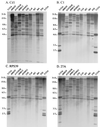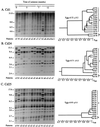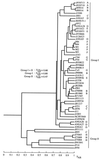Development and characterization of complex DNA fingerprinting probes for the infectious yeast Candida dubliniensis
- PMID: 10074523
- PMCID: PMC88646
- DOI: 10.1128/JCM.37.4.1035-1044.1999
Development and characterization of complex DNA fingerprinting probes for the infectious yeast Candida dubliniensis
Abstract
Using a strategy to clone large genomic sequences containing repetitive elements from the infectious yeast Candida dubliniensis, the three unrelated sequences Cd1, Cd24, and Cd25, with respective molecular sizes of 15,500, 10,000, and 16,000 bp, were cloned and analyzed for their efficacy as DNA fingerprinting probes. Each generated a complex Southern blot hybridization pattern with endonuclease-digested genomic DNA. Cd1 generated an extremely variable pattern that contained all of the bands of the pattern generated by the repeat element RPS of Candida albicans. We demonstrated that Cd1 does not contain RPS but does contain a repeat element associated with RPS throughout the C. dubliniensis genome. The Cd1 pattern was the least stable over time both in vitro and in vivo and for that reason proved most effective in assessing microevolution. Cd24, which did not exhibit microevolution in vitro, was highly variable in vivo, suggesting in vivo-dependent microevolution. Cd25 was deemed the best probe for broad epidemiological studies, since it was the most stable over time, was the only truly C. dubliniensis-specific probe of the three, generated the most complex pattern, was distributed throughout all C. dubliniensis chromosomes, and separated a worldwide collection of 57 C. dubliniensis isolates into two distinct groups. The presence of a species-specific repetitive element in Cd25 adds weight to the already substantial evidence that C. dubliniensis represents a bona fide species.
Figures








References
-
- Anthony R M, Midgley J, Sweet S P, Howell S A. Multiple strains of Candida albicans in the oral cavity of HIV-positive and HIV-negative patients. Microb Ecol Health Dis. 1995;8:23–30.
-
- Carlotti A, Srikantha T, Schröppel K, Kvaal C, Villard J, Soll D R. A novel repeat sequence (CKRS-1) containing a tandemly repeated subelement (kre) accounts for differences between Candida krusei strains fingerprinted with the probe CkF1,2. Curr Genet. 1997;31:255–263. - PubMed
-
- Chindamporn A, Nakagawa Y, Nizuguchi I, Chibana H, Doi M, Tanaka K. Repetitive sequences (RPSs) in the chromosomes of Candida albicans are sandwiched between two novel stretches, HOK and RB2, common to each chromosome. Microbiology. 1998;144:849–857. - PubMed
Publication types
MeSH terms
Substances
Grants and funding
LinkOut - more resources
Full Text Sources

